He-He-Heidelberg!
/
Dear Faithful Readers (aka our parents),
We apologize greatly for the huge gap in our blog entries. There's no excuse for it really, it's not like we really haven't had the time in the last month to post a few pictures and words up, it's just that we're lazy. And since most of the planned entries are about traveling, it becomes a lot harder to remember what the name of that one Romanesque cathedral in Tuebingen was or whatever, which makes the process of updating more tedious, because I have to look it up. Anyway. Let's slog through some pictures of Heidelberg, which we went to like, more than a month ago!
Puttin' on my tour guide voice now. Heidelberg is a famous University town because it was German's first university town. Although it's located in the present-day state of Baden-Wurttemberg, like Stuttgart, historically Heidelberg was the former location of the Electoral Palatinate, and we still haven't quite figured out what that means, but it had something to do with the dizzyingly complex politics of the former Holy Roman Empire. As far as I can gather, unlike Stuttgart, Heidelberg is not part of Swabia and culturally and historically is more associated with the Rhineland, which is also nebulous geographically and culturally. The city was founded in the 12th century although settlements existed before that. The University was founded in the early 1400s, and the city became the center of the influential German Romantic movement in the beginning of the 19th century. So you can thank Heidelberg for Byron, sort of. It is also next to the town of Mannheim, of the steamrollers.
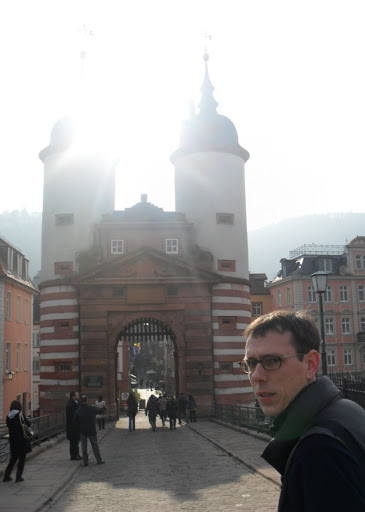
Heidelberg's main landmarks include this bridge over the Neckar river, the University, and it's castle up on the hillside. The old town consists of the largest pedestrian zone in Germany, and is full of shops, restaurants, historical parts of the University, and churches.

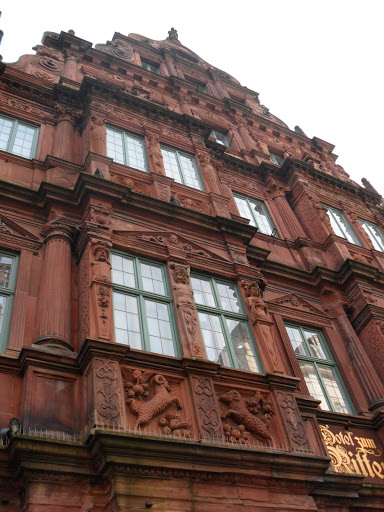
This is the Knight's House from 1592. It's pretty.
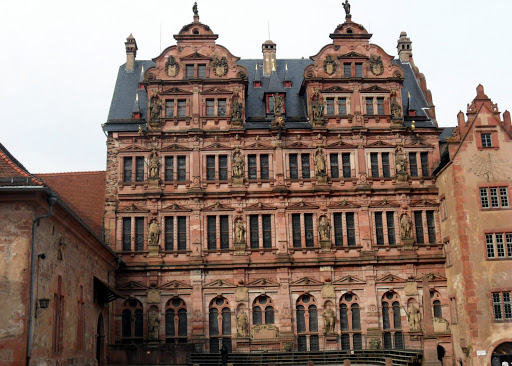
The "Schloss" (which is German for castle or palace) in Heidelberg is a mishmash of styles, since people have basically been building and adding to it over the course of centuries. This is the Fredrichsbau, built in the early 1600s. The figures are the family Wittlesbach counts, and they trace their line from Charlemagne, who is represented as well.

The castle also includes a ginormous wine barrel, straight out of my most fevered dreams. Legend has it that the court jester died as a result of drinking the entire barrel. They have a monument to him, which is fitting. Chris does not believe this actually happened.
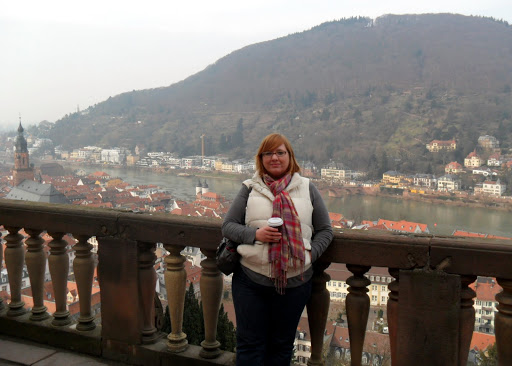
Since the schloss is on a rocky outcrop above the city, it provides amazing views. Also they provide hot spiced wine in to-go cups for touring the palace, which is pretty thoughtful of them.
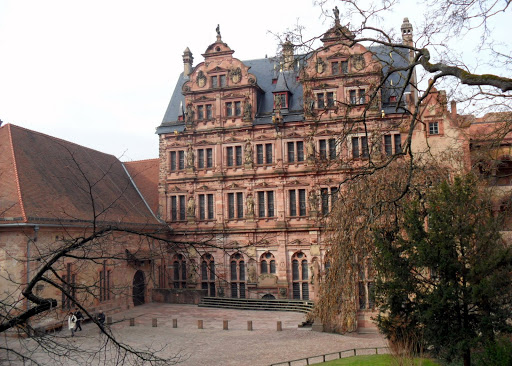
The schloss courtyard

The castle is under renovation, and huge parts of it are ruined, thanks to the French destroying it with cannons on more than one occasion.
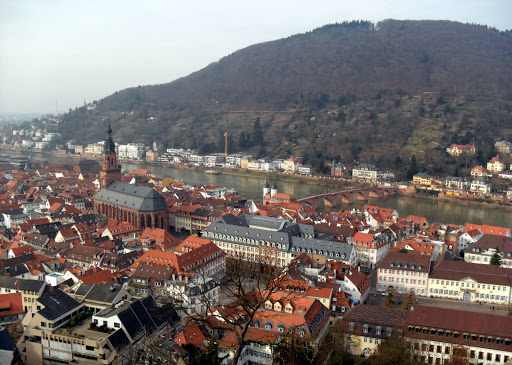
Another view of the city.
Heidelberg has three beautiful and historic churches, but none of my pictures of them turned out particularly well. Unsurprisingly, Heidelberg also had a large Jewish community at various times throughout history, and many taught at the University, although various anti-Semitic laws often prevented Jews from being full professors. The Nazis re-introduced those rules after a century of tolerance, and during Krystallnacht the old Jewish synagogue was destroyed. A memorial is there today.
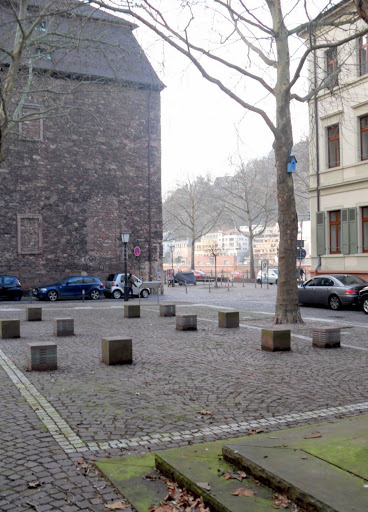
Being a university town set between forested hills and students on bikes, it doesn't feel unlike Berkeley, if Berkeley had a big river and tons of 18th-century buildings. Ok, so it's not really like Berkeley, but there are chaat places and more international cusine and hip bars than you generally find in historic German towns. The fact that Heidelberg is the warmest city in Germany and has quite a few Mediterraneans plants and orchards gives it a lush air, or so I'm told. It was February when we visited!
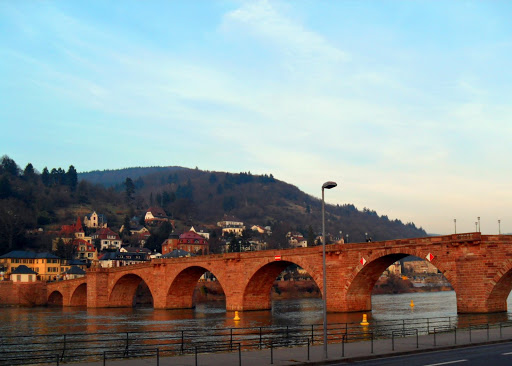
All in all it was a lovely place to visit with a host of museums we didn't get to check out, so we're looking forward to returning and enjoying the famous warm weather later in the spring. You can check out a lot more pictures at our gallery here. And now I leave you with: a monkey.
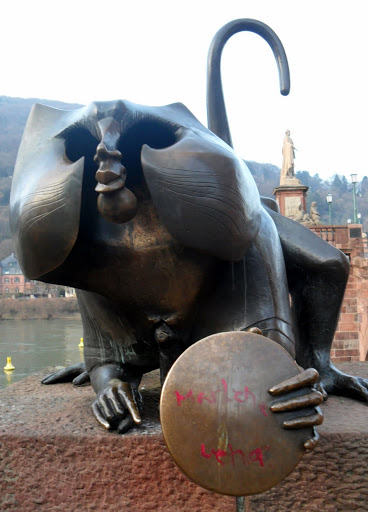
We apologize greatly for the huge gap in our blog entries. There's no excuse for it really, it's not like we really haven't had the time in the last month to post a few pictures and words up, it's just that we're lazy. And since most of the planned entries are about traveling, it becomes a lot harder to remember what the name of that one Romanesque cathedral in Tuebingen was or whatever, which makes the process of updating more tedious, because I have to look it up. Anyway. Let's slog through some pictures of Heidelberg, which we went to like, more than a month ago!
Puttin' on my tour guide voice now. Heidelberg is a famous University town because it was German's first university town. Although it's located in the present-day state of Baden-Wurttemberg, like Stuttgart, historically Heidelberg was the former location of the Electoral Palatinate, and we still haven't quite figured out what that means, but it had something to do with the dizzyingly complex politics of the former Holy Roman Empire. As far as I can gather, unlike Stuttgart, Heidelberg is not part of Swabia and culturally and historically is more associated with the Rhineland, which is also nebulous geographically and culturally. The city was founded in the 12th century although settlements existed before that. The University was founded in the early 1400s, and the city became the center of the influential German Romantic movement in the beginning of the 19th century. So you can thank Heidelberg for Byron, sort of. It is also next to the town of Mannheim, of the steamrollers.
Heidelberg's main landmarks include this bridge over the Neckar river, the University, and it's castle up on the hillside. The old town consists of the largest pedestrian zone in Germany, and is full of shops, restaurants, historical parts of the University, and churches.
This is the Knight's House from 1592. It's pretty.
The "Schloss" (which is German for castle or palace) in Heidelberg is a mishmash of styles, since people have basically been building and adding to it over the course of centuries. This is the Fredrichsbau, built in the early 1600s. The figures are the family Wittlesbach counts, and they trace their line from Charlemagne, who is represented as well.
The castle also includes a ginormous wine barrel, straight out of my most fevered dreams. Legend has it that the court jester died as a result of drinking the entire barrel. They have a monument to him, which is fitting. Chris does not believe this actually happened.
Since the schloss is on a rocky outcrop above the city, it provides amazing views. Also they provide hot spiced wine in to-go cups for touring the palace, which is pretty thoughtful of them.
The schloss courtyard
The castle is under renovation, and huge parts of it are ruined, thanks to the French destroying it with cannons on more than one occasion.
Another view of the city.
Heidelberg has three beautiful and historic churches, but none of my pictures of them turned out particularly well. Unsurprisingly, Heidelberg also had a large Jewish community at various times throughout history, and many taught at the University, although various anti-Semitic laws often prevented Jews from being full professors. The Nazis re-introduced those rules after a century of tolerance, and during Krystallnacht the old Jewish synagogue was destroyed. A memorial is there today.
Being a university town set between forested hills and students on bikes, it doesn't feel unlike Berkeley, if Berkeley had a big river and tons of 18th-century buildings. Ok, so it's not really like Berkeley, but there are chaat places and more international cusine and hip bars than you generally find in historic German towns. The fact that Heidelberg is the warmest city in Germany and has quite a few Mediterraneans plants and orchards gives it a lush air, or so I'm told. It was February when we visited!
All in all it was a lovely place to visit with a host of museums we didn't get to check out, so we're looking forward to returning and enjoying the famous warm weather later in the spring. You can check out a lot more pictures at our gallery here. And now I leave you with: a monkey.